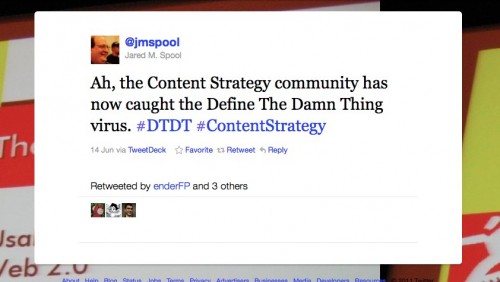Thoughts on “Defining the Damn Thing”
June 15, 2011
Jared’s right. In the past two years I’ve seen talk of content strategy shift from “we need to do this now” to “we need to claim our space,” and the rush to define the industry has likewise shifted from “this is what we do” to “this is what we control.”
One of the most frustrating elements of any user experience field is the perceived need to define each position in a way that sections off certain deliverables and skills, like some kind of UX land grab. Truth is, depending on a project, we all share skills. The definition changes.
Until there’s some defining group that says, once and for all, THIS IS WHAT CONTENT STRATEGY IS, there will be no consensus. There can’t be. Humankind is simply too stubborn and proud to concede – especially a group of nerds like us, who have spent decades being stubborn and proud over the smallest apostrophes and grammar usage.
Ask a web designer to define the field. Or a developer. No one is going to have the same answer. And that’s okay, as long as there’s an industry-wide consensus as to what the final product is.
In a web designer’s case, that final product is a design that contributes to a useful and usable website. In a developer’s case, it’s functionality that contributes to a useful and usable website.
In our case as content strategists, it’s content and governance that contributes to – wait for it – a useful and usable website.
I work on the web, so I will continue to work with the same definition I’ve always used: “Content strategy is the practice of planning for content creation, delivery, and governance of useful, usable content.” And I will do what I feel I need to do for my clients, regardless of whether it fits into the canonical definition of content strategy.
In other words, YES. Let’s define the damn thing. But not at the expense of actually executing the damn thing.


